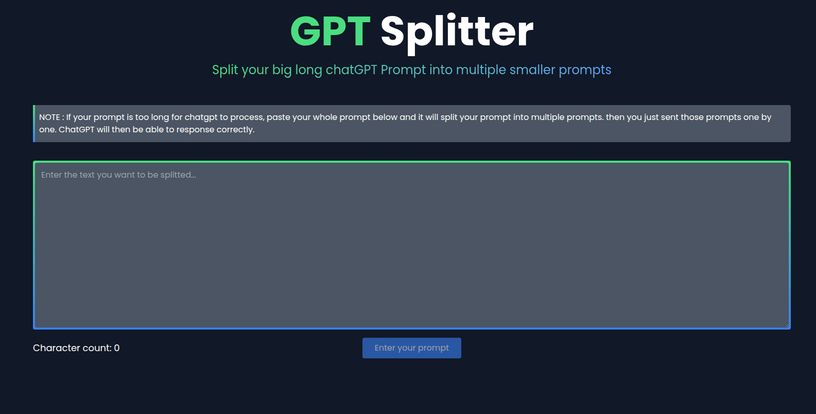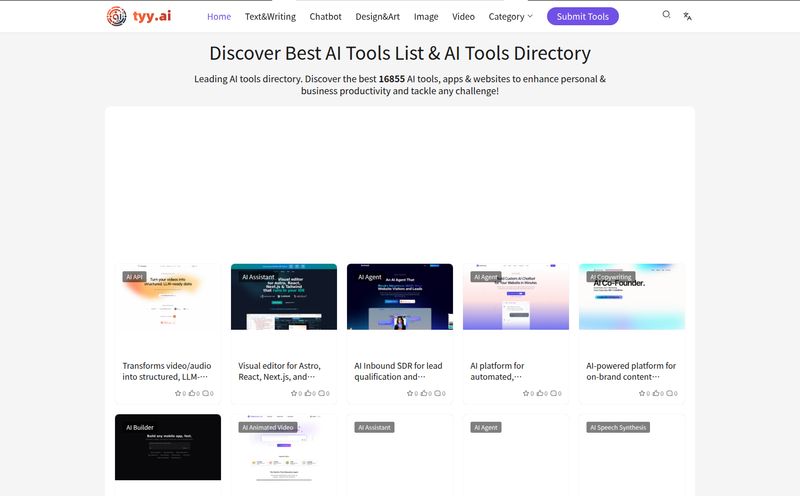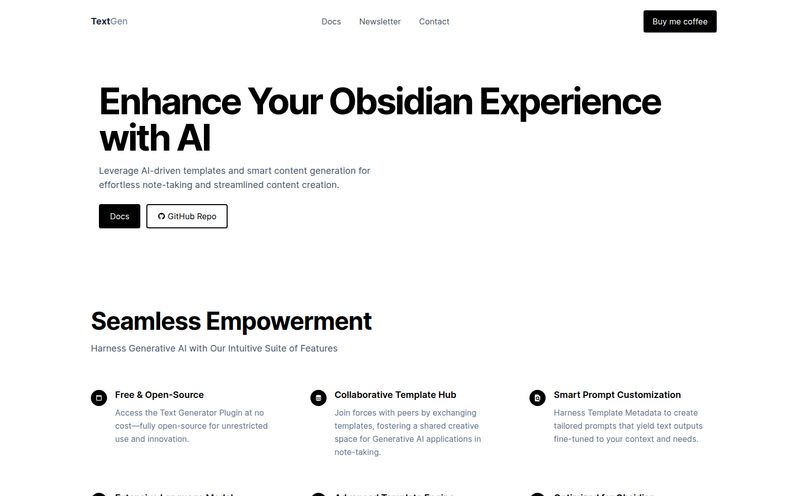Alright, let’s talk. You and me. We’ve all been there. You spend a solid half hour crafting the perfect prompt for ChatGPT. It’s a work of art. You've included all the context, the data, the specific instructions, the negative constraints… you hit Enter, lean back in your chair, and feel like a proper genius.
And then… nothing. Or worse, you get that dreaded, soul-crushing error: “The message you submitted was too long, please reload the conversation and submit something shorter.”
Ugh. It feels like explaining a brilliant movie plot to someone who just keeps interrupting to ask what a movie is. All that work, down the drain. For years, the workaround has been a pain. Manually chopping your text into chunks, trying to guess where the character limit is, and then feeding them to the AI one by one, praying it remembers the context from Part 1 when it gets to Part 4. It’s tedious. It’s imprecise. And honestly, it kills my creative flow.
But a few weeks ago, I stumbled upon a tool so simple, so obvious, that I was almost mad I hadn’t thought of it myself. It’s called GPT Splitter, and it’s become my go-to utility for any serious AI work.
What Exactly is GPT Splitter? (And Why You Need It)
Look, this isn't some revolutionary new AI model. It’s not going to write your content for you. What it is, is a beautifully simple web tool that does one thing and does it perfectly: it splits your giant wall of text into ChatGPT-friendly pieces.
Think of it like a digital deli slicer for your prompts. You have a big, unwieldy block of text (the prosciutto, if you will), and GPT Splitter slices it into thin, perfectly digestible pieces for the AI to consume without choking. The interface is about as minimalist as it gets: a big box to paste your text into, a character counter, and a button. That’s it. No fluff.

Visit GPT Splitter
It’s a lifesaver for anyone in SEO, content creation, development, or research who needs to feed large amounts of information—like a full article for summarization, a long code file for debugging, or a dense research paper for analysis—into ChatGPT.
My Hands-On Experience: Putting the Splitter to the Test
So, of course, I had to kick the tires. I grabbed a 2,000-word blog post I was working on about Core Web Vitals (a notoriously dry topic, I know) and pasted the whole thing into the GPT Splitter text box. I hit “Enter your prompt,” and boom.
Instantly, the tool broke my article down into a series of numbered chunks, each neatly labeled: “Part 1/5,” “Part 2/5,” and so on. It also automatically adds a little instruction at the end, telling the AI something along the lines of, “When you have received all the parts, I will ask you to perform the task.” Clever.
Now, here’s the catch. You do still have to copy and paste these chunks into ChatGPT one by one. It’s not a fully automated API integration. But let me tell you, clicking copy-paste five times is a world away from the headache of manually highlighting, cutting, and guessing where the breaks should be. It turns a 10-minute frustrating task into a 30-second mindless one. I’ll take that trade any day of the week.
The Good, The Bad, and The... Well, It's Pretty Simple
No tool is perfect, not even one this straightforward. After using it for a while on different projects, here's my honest take.
The Big Wins (The Good)
The most obvious advantage is the time and sanity it saves. It just removes a point of friction from my daily workflow, and those little things add up. I find myself more willing to take on complex AI tasks now because I know I won't hit that character limit wall. It encourages more ambitious prompting, which is where the real magic of AI happens. Instead of asking for a summary of a concept, I can now provide an entire document and ask for a nuanced analysis of its tone, arguments, and factual accuracy. That's a huge step up.
A Few Minor Quibbles (The Bad)
Okay, it's not all sunshine and rainbows. As I said, you still have to do the manual copy-paste dance. I’d love a “copy all chunks” button, but it’s a small complaint.
The bigger issue, and it's something to be aware of, is that the splitting logic is mechanical. It seems to be based purely on character or chunk count. For prose, this is usually fine. But if you’re splitting a piece of code, it might cut a function right in half. The splitting logic isn't always perect, so a quick once-over of the chunks is a good idea if you're working with something highly structured. It's a smart tool, not a genius one.
How Much Does This Magic Cost?
This is my favorite part. It appears to be completely free. I looked for a pricing page, I really did. The anemic footer on their site has no link, and any direct URL snooping I did led to a 404 error. In the world of SaaS and freemium apps, a broken pricing page is usually code for “we haven’t gotten around to charging for this yet.” So, for now, it costs nothing. Zero. Zilch.
Will that last forever? Who knows. But right now, it’s a free utility that solves a real problem, and you can’t argue with that.
Who is GPT Splitter For?
Honestly, if you're a heavy ChatGPT user, you'll probably find a use for this. But it’s especially helpful for:
- Content Marketers & SEOs: Need to analyze a competitor’s 3,000-word article? Or want ChatGPT to rewrite your own long-form post in a different style? This is your tool.
- Developers & Programmers: Pasting long scripts, log files, or code blocks for debugging or explanation is now trivial.
- Students & Researchers: Got a 20-page PDF of a scientific study you need to understand? Convert it to text, paste it in the splitter, and ask the AI for a summary, key findings, or a list of counterarguments.
- Business Professionals: Feeding long meeting transcripts, business reports, or legal documents to get summaries and action items.
It's a power-user tool that democratizes long-form prompting.
A Quick Guide on Maximizing Your Long Prompts
Just using the tool is great, but you can get even better results with a bit of prompt engineering. Here’s a little trick I’ve been using:
Before you paste the first chunk, prime ChatGPT with an initial prompt. Something like this:
“Hi ChatGPT. I am about to give you a long document that has been split into 5 parts. Please do not do anything or start your analysis until I have sent all 5 parts. For each part I send, just reply with 'Received Part [X of 5]' and nothing else. I will tell you when I have sent the final part by saying 'ALL PARTS SENT'.”
This sets clear expectations for the AI. It prevents it from getting confused or trying to summarize Part 1 before it has the full context of Part 5. It puts you in control of the conversation and leads to much more coherent and accurate final outputs.
A Simple Solution to a Common Problem
In an industry filled with complex platforms and overhyped “game-changers,” there’s something deeply satisfying about a tool like GPT Splitter. It doesn't promise to revolutionize your life. It just promises to fix an annoying problem, and it delivers on that promise without any fuss.
It’s not a show horse; it’s a workhorse. And it’s earned a permanent spot in my browser bookmarks. So next time you're staring at that “message too long” error, don't rage-quit your browser. Just slice it up.
Frequently Asked Questions about GPT Splitter
- Is GPT Splitter free to use?
- As of right now, yes. The tool is completely free to use. There is no pricing information on their website, and no features appear to be locked behind a paywall.
- Does GPT Splitter store or save my data?
- This is a great question. The tool appears to process the text client-side (in your browser), which is good for privacy. However, like with any free online tool, I would personally avoid pasting highly sensitive or confidential information, like private company data or personal credentials. Always exercise caution.
- Is there a limit to how much text GPT Splitter can handle?
- I've tested it with several thousand words without any issues. While there's likely a technical limit based on what a web browser can handle, for all practical purposes, it should be able to manage any prompt that's too long for ChatGPT itself.
- Why can't I just send a long prompt to ChatGPT directly?
- AI models like ChatGPT have a context window—a limit on how much text (measured in 'tokens') they can process at once. This includes both your prompt and its own response. If your input prompt is too long, the model can't process it, leading to errors or truncated, incomplete responses.
- Are there alternatives to GPT Splitter?
- The main alternative is doing it yourself! You can manually copy and paste chunks of text. There are also more advanced solutions, like using the OpenAI API with custom Python scripts that handle chunking automatically, but that requires technical skill. For a simple, no-code solution, GPT Splitter is fantastic.



